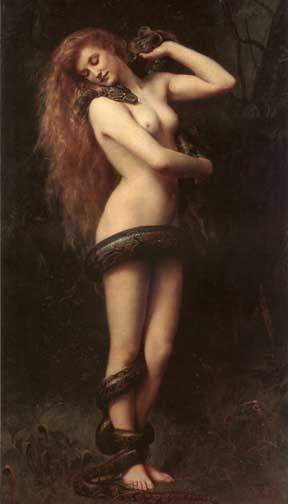

Masks - There are women who, however you may search them, prove to have no content but are purely masks. The man who associates with such almost spectral, necessarily unsatisfied beings is to be commiserated with, yet it is precisely they who are able to arouse the desire of the man most strongly: he seeks for her soul - and goes on seeking (I Human All Too Human, 405).Moreover, seeking for her soul means seeking for her missing penis. To primitive people, and to our unconscious, the soul is something very concrete. It is similar to the body, with shape and weight, just not visible (see: James George Frazer, The Golden Bough, Oxford University Press, New York 1994, Chapter 11). Only later civilizations transformed it into an abstract concept. As Frazer reports, some Indians, when a man is supposed to have lost his soul, �catch a man�s lost soul in his boots and restore it to his body by putting his feet into them� (op.cit. p.158). In this case, the unconscious associative chain is: soul � boots � feet. As we already know, the foot is a penis substitute (S.Freud, "Symbolism in Dreams", in op.cit., pp.155-6), like in Oedipus' myth, whose name means "inflated legs", and as such, its right place is in the boot, which is synonymous of female genital. Henceforth, the soul is a penis (Cf. Cinderella and "The Puss with the Boots").
If anyone still harbours any doubt on the masturbative substance of the representation of a woman with a serpent, I suggest the following web site: Snakes
Why, is THIS lady so erotically arousing?
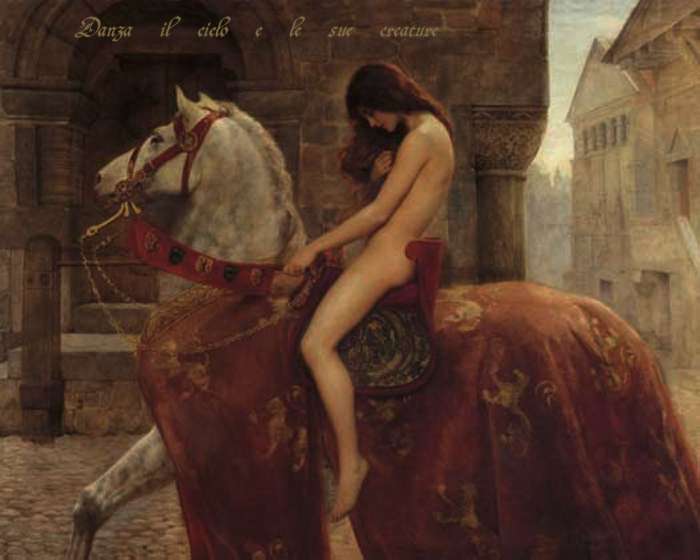
Again, a fluent hair, and this time a gigantic penis between her legs.
The horse, like the Trojan horse, is the symbol of the male's member.
With Abraham's words: "the idea that the female has concealed within her a very large penis into which the smaller organ of the man must penetrate" (3).
Henceforth, the enormous masculine penis between the legs of the girl. She owns a member like the masculine one, but even bigger.
In Catholic art, Mary Magdalene is always represented with a long fluent hair, and she usually stands or sits near Jesus' legs.
In some paintings, the Saint-harlot is represented wiping the leg of Jesus with her fluent gorgeous hair, as we are told by the Gospels (John 12:3).
The leg is the one of Oedipus, whose name means "with the inflated leg". Abraham has shown, describing the fantasy of one of his patients, ("Transformations of Scoptophilia" (1913), in Selected Papers of Karl Abraham, Hogart Press, London 1927, p.179) that the leg is a displacement from the penis, and Q.Zangrilli (4) emphasized this point, underlining that that is also the member on which the Primeval Father inflicted castration.
Therefore, the painting below describes the moment in which the penis of the Christ, the Vicar of the Brotherhood Horde, unites with the female genital, the object of the collective desire (5).
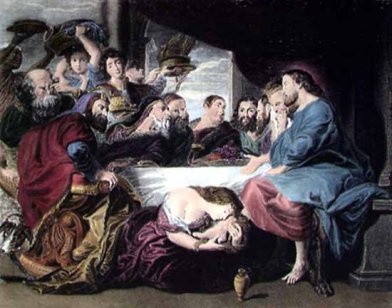
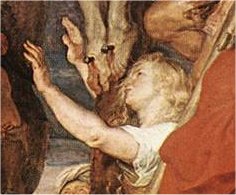
As is written in the Gospel:
And she had a sister called Mary, who sat at the Lord's feet and listened to his teaching. But Martha was distracted with much serving; and she went to him and said "Lord, do not care that my sister has left me to serve alone? Tell her then to help me. But the Lord answered her, "Martha, Martha, you are anxious and troubled about many things; one thing is needful. Mary has chosen the good portion, Which shall not be taken from her (Luke, 10:39-42)
Mary has chosen the leg, "the good portion".
Indeed:
Mary took a pound of costly ointment of pure nard and anointed the feet of Jesus and wiped his feet with her hair; and the house was filled with the fragrance of the ointment (John 12:3)
The fragrance came from Jesus' feet.
Karl Abraham (� Remarks on the Psychoanalysis of a Case of Foot and Corset
Fetishism � (1910), in op.cit.) has shown that the drive towards the odor of the foot is a displacement from the genital. Humans, like other mammals, lust for the odor of the genital. In the process of repression, the lust is displaced into the feet, and it is fixated there, as in fetishist perversions. For instance, as is the case with the Chinese, who in the past used to masturbate with the twisted feet of their women. The bound foot represented the materialization of the missing (and fantasized) female penis.
As
Chiara Lesperance has kindly reported to me, the French, when they want to say that they are fed up, they say "Je me suis cass�e les pieds" (I have broken my feet), which symbolizes self - castration. In Italian, there is an equivalent expression in which, instead of "pieds" (feet), is specifically said "cazzo" (dick), and so also in Hebrew.
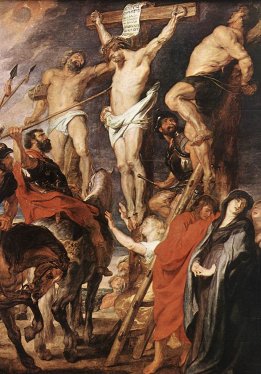
Rubens at the Alte Pinakothek - Munich
Dieric the Elder: Christ in the House of Simon
Mary Magdalene is not the only lover who focalizes on the feet of her beloved one. Juliet, who became the household name for a female - in love in western literature, says: "And all my fortunes at thy foot I'll lay, And follow thee, my lord throughout the world" (Romeo and Juliet, Act II, Scene II).
It is not casual that Juliet, like Mary Magdalene, is always represented with a long fluent hair. Rapunzel, the heroine in Grimm's tale, owns a long golden hair, too, climbing on which her lover can reach her.
Links:
Rapunzel and Other Stories of Beautiful Hair
Caravaggio and La Madonna del serpente
Jesus and Mary Magdalene, the Harlot of the Horde
Duccio and La Madonna dei Francescani
Cinderella and "The Puss with the Boots"
Truth Is a Woman: Bernini - Giorgione - Manet
(1) "The History of an Infantile Neurosis", in The Standard Edition of the Complete Works of Sigmund Freud, Ed. and Trans. J. Strachey, Hogarth Press, London 1964, Vol.XVII, pp.121-2).
(2) Medusa, the Female Genital and the Nazis, and Caravaggio and La Madonna del serpente
.
See also: Iakov Levi, "Biancaneve e altre vergini", capitolo secondo, nota 9, in Scienza e psicoanalisi. Rivista multimediale di psicoanalisi e scienze applicate, [Entered 8 Settembre 2002].
See also, Iakov Levi, Eva. Verginità e castrazione nel mito greco e nell'Oriente semitico
Freud says that the serpent is one of the "less understood" male phallic symbols.
("Introductory Lectures on Psycho - Analysis; Symbolism in Dreams", 1915 - 1917, in The Standard Edition of the Complete Works of Sigmund Freud, Ed. and Trans. J. Strachey, Hogarth Press, London 1964, Vol.XV, pp.149-155).
Although Freud defines the snake as a male phallic symbol, he was induced into error by the fact, as he himself says, that the woman is fantasized having a penis similar to the masculine one ("The History of an Infantile Neurosis", in op.cit., Vol.XVII, pp.121-2).
Therefore, we should not wonder if there is some confusion on the substance of the female penis, as the child himself is very confused on this issue.
In a letter to Fliess dated the 26th July 1904 he says: “Until now I did not know what I learned from your letter-that you are using [the idea of] persistent bisexuality in your treatments. We talked about it for the first time in Nuremberg while I was still lying in bed, and you told me the case history of the woman who had dreams of gigantic snakes. At that time you were quite impressed by the idea that undercurrents in a woman might stem from the masculine part of her psyche.” (The Complete Letters of Sigmund Freud and Wilhelm Fliess 1887-1904, Translated by Jeffrey Moussaieff Masson,The Belknap Press of Harvard University Press Cambridge – Massachusetts, and London-England, 1995, p.465)
Therefore, Freud had unconsciously perceived that the right association is "serpent = phallic masculine part of the woman", namely, the clitoris as pre- vaginal phallic stage. If he had interpreted the snake as a male penis he would not have raised the question of ambisexuality in this context, and he would have interpreted the dream of the woman as a desire for the male penis.
In one of his last works, published posthumous, Freud hinted that he was close to draw the right conclusion:
The terror of the Medusa is thus a terror of castration that is linked to the sight of something. The hair upon the Medusa's head is frequently represented in works of art in the form of snakes, and these once again are derived from the castration complex. It is a remarkable fact that however frightening they may be in themselves, they nevertheless serve as a mitigation of the horror, for they replace the penis, the absence of which is the cause of the horror. This is a confirmation of the technical rule according to which a multiplication of penis symbols signifies castration (Medusa's Head, 1940).The snakes are placed on Medusa's head. Therefore, they are the representation of her penis, and not that of the male.
A comedy by Anzengruber shows how a simple peasant lad is deterred from marryng his intended bride because she is "a wench who'll cost her first his life". For this reason he agrees to her marrying another man and is ready to take her when she is a widow and no longer dangerous. The title of the play, Das Jungferngift ["Virgin's Venom"], reminds us of the habit of snake - charmers, who make poisonous snakes first bite a piece of cloth in order to handle them afterwards without danger ("The Taboo of Virginity", 1918 [1917], in The Standard Edition of the Complete Works of Sigmund Freud, Ed. and Trans. J. Strachey, Hogarth Press, London 1957, Vol.XI, p.206)Freud's association between snakes first bite and the woman's imene is enlightening.
LXXVIII. This was how Croesus reasoned. Meanwhile, snakes began to swarm in the outer part of the city; and when they appeared the horses, leaving their accustomed pasture, devoured them. When Croesus saw this he thought it a portent, and so it was. [2] He at once sent to the homes of the Telmessian interpreters,1 to inquire concerning it; but though his messengers came and learned from the Telmessians what the portent meant, they could not bring back word to Croesus, for he was a prisoner before they could make their voyage back to Sardis. [3] Nonetheless, this was the judgment of the Telmessians: that Croesus must expect a foreign army to attack his country, and that when it came, it would subjugate the inhabitants of the land: for the snake, they said, was the offspring of the land, but the horse was an enemy and a foreigner. This was the answer which the Telmessians gave Croesus, knowing as yet nothing of the fate of Sardis and of the king himself; but when they gave it, Croesus was already taken (Hist., I:78, Ed. A.D.Godley)."the snake, they said, was the offspring of the land, but the horse was an enemy and a foreigner". Meaning, the snake is a phallic symbol and an offspring of the Land, herself the symbol of the Mother. It comes from her, it is her penis. The horse, instead, is an enemy. He comes from outside. Meaning, he is a male phallic symbol, an outsider, like the masculine penis, which is outside and strives to penetrate her. Like the Troian horse, which deflowered the city.
But of new monsters, Earth created more.
Unwillingly, but yet she brought to light
Thee, Python too, the wondring world to fright,
And the new nations, with so dire a sight:
So monstrous was his bulk, so large a space
Did his vast body, and long train embrace. (Metam., I: 435 - 445, Transl. by Sir Samuel Garth, John Dryden)
(3) Karl Abraham, "An Infantile Sexual Theory not Hitherto Noted" (1925), in Selected Papers of Karl Abraham, with an introductory memoir by Ernest Jones, translated by Douglas Bryan and Alix Strachey, Hogart Press, London 1927, pp.335-336.
(4) Quirino Zangrilli, Edipo: rappresentazione antropomorfica del conflitto vitale , in http://www.micropsicoanalisi.it/zangrilli/p/edipo.htm [Entered 1/16/2003]
(5) As is written in the Gnostic Gospel of Saint Philip, Mary Magdalene was the most beloved of Jesus' Disciples. She was his lover and companion:
“And the companion of the [Savior is] Mary Magdalene. [But Christ loved] her more than [all the disciples [and used to] kiss her [often] on her mouth. The rest of [the disciples were offended by it [and expressed disapproval]. They said to him, "Why do you love her more than all of us?" The Savior answered and said to them, "Why do I not love you like her? When a blind man and one who sees are both together in darkness, they are no different from one another. When the light comes, then he who sees will see the light, and he who is blind will remain in darkness" (NHC II.3.63.32ff) (Robinson 1977: 138).For Jesus as the rebellious son, and leader of the horde of the brothers that acted out the primeval patricide, see: Pinocchio. The Puberty Rite of a Puppet